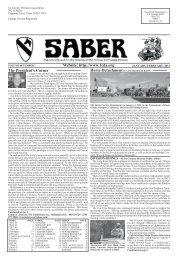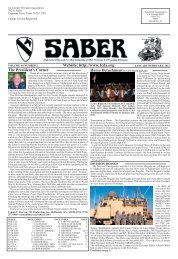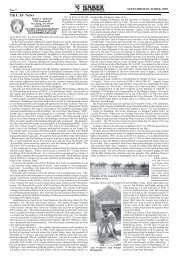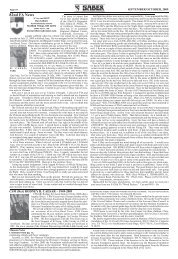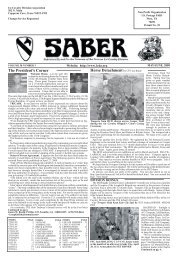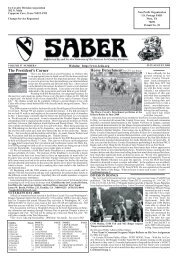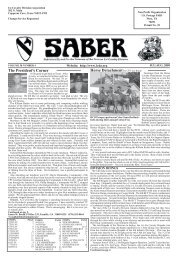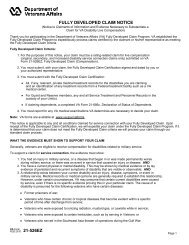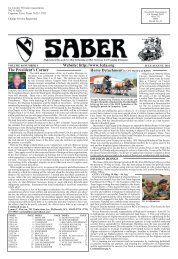Jan Feb '09 Saber.indd - First Cavalry Division Association
Jan Feb '09 Saber.indd - First Cavalry Division Association
Jan Feb '09 Saber.indd - First Cavalry Division Association
- No tags were found...
You also want an ePaper? Increase the reach of your titles
YUMPU automatically turns print PDFs into web optimized ePapers that Google loves.
JANUARY/FEBRUARY, 200920th and 79th Artillery Regiment NewsRuss Warriner10845 SE 178th St.Summerfield, FL 34491(352) 307-9310arace@aerial-rocket-artillery.orghttp://www.aerial-rocket-artillery.orgHello fellow Alumni. As I sit here at the keyboard typing this issue of the <strong>Saber</strong>the holiday season has come and gone. I hope that when everyone sat down toenjoy their special meals that they said a prayer for our troops. As always mythoughts were not only on our Blue Max unit C 1-10 but all the other units andtheir members so far away from their families. As I crank up my computer muchof my article will be based on the good and not so good feelings this holidayseason had for many of us.---- UPDATE ON RICKENBACKER ----Ernest W. RICKENBACKER AKA Fast Eddie was laid to rest in ArlingtonNational Cemetery on December 2nd. In addition to Rick’s family, Jim MA-CLACHLAN, Warren CHUNN, Art JETTER and Marco CORDON, who servedwith Rick, attended the services. Jim MACLACHLAN credits Rick with saving hislife by pulling him from a burning Cobra on October 12, 1971. Mike SLONIKER,who was an A/229 1CAV Huey pilot escorted by Blue Max, also attended.Mike SLONIKER attended 41 Arlington services since 29 August, 1989 whenone of our Blue Max members was interred. Thank you, Mike. You have alwayssupported the ARA/AFA and Blue Max.---- UPDATE ON BLUE MAX C 1-10 ----E-mail message from the <strong>First</strong> Sergeant of Blue Max C 1-10: “The troops arrivedin northern Iraq and have been flying missions 24 hours a day without anyincidents thus far. In just three weeks we’ve flown almost 600 total hours andhave maintained an Operational Readiness Rate, which exceeds unit, brigadeand Army standards.The Soldiers still have high moral and they are busting their humps to keepthese Apaches in the air so that they’re providing security for our brothers onthe ground. I, of course, cannot mention details of engagements or missions butthe pilots are motivated and doing an outstanding job. They are putting in longhours and are focused on their mission and are making us proud. I could notpossibly ask for any better Soldiers and Aviators that I have the absolute pleasureof serving with over here in the Blue Max. Those of you that came before uswould be proud of the job that they’re doing, just as we’re proud of the job thatyou guys performed during your tours of service for our great nation. It’s alwaysgreat to hear from you and I hope that all is well with you and your family. Godbless and take care.”Thank you Top, we pray for the safety of ALL our troops and will be glad tohear of the return of our Blue Max as well as ALL our troops.We have a full list of troops and a mailing address but have been asked to notpublish it due to security issues. We also have a list of their families here in thestates and will be supporting them in any way we can.---- STILL SERVING ----CW4 Gordon EATLEY who served with C 2-20 in 1967 just send us an e-mailfrom Iraq. He wrote, “Forty three years of fun and games, and more time in thecockpit than I care to remember.”He just arrived in Iraq so he will not be home until about this time next year.We wish him a safe tour and plan to stay in touch.---- THE TIMES ARE A’ CHANGING ----When we look around us and see the hardships that others are going through, itreminds us of what we have gone through or maybe what we are going throughright now. The loss of a friend who was like a brother or family member canThe AdmiraltiesContinued from pg. 17.on targets when called upon.The LST’s came in just before 1000 while B-25’s were bombing enemy positions.Light and ineffective enemy mortar and machinegun fire from north ofthe skidway was countered by the 40-mm machine guns and .50-caliber machineguns of the antiaircraft battery from the decks of the LST’s, which also got goodpractice with their 20-mm, 40-mm, and 3-inch guns.The big boats grounded to a stop, the doors swung open, and men of the supportforce spread out on the narrow beach. Bulldozers, the first vehicles to land,began to construct ramps for unloading supplies and vehicles. Sniper fire wasencountered on the right flank of the beachhead where the 40th ConstructionBattalion had been assigned a defense section. The battalion’s ditch-digger, acomplicated machine that only one man in the unit had the patience and skill torun, scooped out a trench 300 yards long, which was protected by Seabees armedwith BAR’s and rifles. The battalion’s 20-mm. gun, mounted on a truck, tookposition 20 yards behind the trenchand opened up on the grove acrossthe air strip from which the sniperfire had come.Piles of ammunition and a largeamount of construction equipmentand rations soon clutteredthe beach. Enemy reconnaissanceplanes flew over when the unloadingwas taking place, so it was urgentthat a larger dispersal area than theperimeter allowed be obtained immediately.Accordingly, when Col.Hugh T. Hoffman, commander ofthe 5th <strong>Cavalry</strong> Regiment, arrivedwith the support force, he went toGeneral Chase’s headquarters andparticipated in planning an attackfor the afternoon. All the dispersalareas not yet occupied were to becaptured and consolidated, so thatMap No. 6the perimeter would include roadsPage 18not be described in words.For me, 2008 presented a challenge I had to face with great emotion, havingbeen the founder of the Blue Max ARA <strong>Association</strong>. It was like watching yourchild move away from home. But, after over 14 years, it was something I neededto do. This past May, I met that issue with mixed feelings, turning the group overto the membership. They selected their own slate of officers, started a journeydown a road to a new beginning with all the membership on board.As the new chain of command moved into office, they elected to change thename to the Aerial Rocket Artillery <strong>Association</strong> and to have a reunion in Midland,Texas from April 16th -19th 2009 with Glenn BROWN, in charge of arrangements. Wish I could be at this reunion but it is notpossible. You will all be in my thoughts and I hope that everyone has a greattime at the reunion.---- UNIT HISTORY TIMELINE ----I am trying to compile what I am calling a UNIT HISTORY TIMELINE. Ihave a lot of history but hope to gather information such as when 2-20 changedcall signs such as Tough Barron, Griffin, Armed Falcon and Blitzkrieg from thelist of many call signs used in Vietnam. Case in point, we know that the BlueMax call sign came into play sometime in early to mid April, 1968 when CPTJerry BARLOCO returned from R&R in Hawaii and brought a Blue Max shirtwith him. Battalion was asking for suggestions for a new radio call sign and therest is history.I am also collecting information on when each battery got their first Cobras.Some research finds dates which do not match what we know as fact. Remember,we want to cover ALL the ARA units as we collect this history.If anyone has anything showing when something took place please contactme.---- TAPS ----James W. “Buggs” Moran, 61, of Baldwinville, Massachusetts,died unexpectedly Wednesday, <strong>Jan</strong>uary 7th, 2009 at hisresidence. He was born in Worcester on <strong>Feb</strong>ruary 23, 1947,the son of the late James Earl and Marjorie Moran.He was an active member with Ovila Case Post 905 VFW andwas its present Quartermaster. He gave speeches at MemorialDay and Veterans Day observances.Jim proudly served in Vietnam with C Btry 2-20th Arty asa pilot. He was a recipient of the Vietnamese Service Medal,Vietnam Campaign Medal, Army Aviator Badge, Good ConductMedal, Silver Star, Distinguished Flying Cross with Oak Leaf Cluster, and numerousAir Medal awards, one awarded for Valor. He was a member of the AerialRocket Artillery <strong>Association</strong> and the Vietnam Helicopter Pilots <strong>Association</strong>.He leaves his wife, of four years, Denise J. (Marcoux) Larson-Moran; one son,Matthew D. Moran and his fiancée Megan MacMahon of Hoboken, New Jersey;three stepchildren, Edward P. Larson of East Templeton, Lori A. Guthrie and herhusband Jody of Baldwinville and Lisa M. Larson and her boyfriend Ryan Daigleof Gardner; four brothers, Ken Moran, Wayne Moran, Gerry Moran and StephenMoran and two step grandchildren, Sadie and Madelyn Guthrie. A sister, CindyMoran, predeceased him.Military funeral services were held Monday, <strong>Jan</strong>uary 12th at the MassachusettsVeterans’ Memorial Cemetery in Winchendon. The family asked that memorialdonations be made to the PACC Scholarship Fund, 171 Kendall Pond West,Gardner, Massachusetts 01440. A guest book was set up on line at where yourthoughts and messages can be left for the family.Until next issue, “Clear Left, Sir!”on both sides and around the southern end of the airfield. Outposts were tobe pushed 100 yards beyond the objective to permit the consolidation of thenew perimeter, and then recalled at dark. The attack was to be supported by anair bombardment, naval gunfire, and artillery, and would be under cover of asmoke screen laid by an LCV (Landing Craft, Vehicle). Both squadrons of the5th <strong>Cavalry</strong> would make the attack.Bombing and strafing by B-25’s, P-38’s, and P-47’s began at 1415. The westernhalf of the airfield and the dispersal area were softened up for the ground attack,and the skidway and Hyane coast beyond were also targets. Bombs were alsodropped on the strip of land forming the northern arm of the harbor. At 1500the 5th <strong>Cavalry</strong> jumped off across the air strip, the newly arrived 1st Squadronon the left and the 2d Squadron on the right. Within an hour the entire airdromewas taken and the troops started to dig in along the line of the western andsouthern dispersal bays (Map No. 6). There were no casualties due to enemyaction. However, the bomb line that had been set at the western edge of the airstrip proved too close. Three bombs landed on an antiaircraft position and on aTroop E position, killing two men and wounding four.The beachhead had been successfully extended against light opposition, butthe new frontage was excessive for the strength of the garrison. It was certainfrom the documents captured on searching the area that the enemy had a force ofabout 1,000 men of a reinforced mixed infantry battalion in the areas south andwest of the airdrome, in addition to antiaircraft personnel. Earlier estimates hadplaced reserves at Lorengau, Lombrum, and Papitalai, totaling more than 2,000troops, and these had also to be reckoned with. Although they had not yet beencontacted, the possible use of these reserves against the north sector from thedirection of Porlaka and the skidway was considered a greater threat than attackby the infantry battalion south of the air strip.Nevertheless, the larger area was necessary for dispersal room, and GeneralChase estimated that the troops on the new perimeter could hold it against acoordinated attack by the Japanese, though some infiltration would be hard toprevent. All units behind the perimeter were therefore ordered to prepare closeinprotection for their arms and equipment.The construction battalion and a combat engineer troop had much work to dobefore they could prepare defenses for the rear areas. The construction battalionhad gone to work at noon on grading and clearing the taxiway. As soon asthe advance across the strip was made, three graders started clearing grass andtop soil from the strip itself. These troops also buried the enemy dead, clearedfiring areas for field artillery and mortars, and demolished enemy dugouts andContinued on pg. 19.



